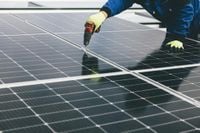In a week marked by seismic shifts in the global energy landscape, regulators and industry leaders on two continents took decisive action to reshape the rules of the game. In Ohio, the fallout from a sprawling bribery scandal reached a dramatic conclusion as utility giant FirstEnergy was ordered to pay over $250 million in fines and refunds. Meanwhile, across the Pacific, South Korea’s solar inverter manufacturers banded together to challenge the country’s overwhelming reliance on Chinese-made equipment, raising urgent questions about energy security and the future of clean power.
On November 19, 2025, the Public Utilities Commission of Ohio (PUCO) delivered a unanimous verdict: FirstEnergy, the Akron-based utility at the heart of a five-year-long corruption saga, must return nearly $187 million to its customers and pay almost $180 million in penalties for misusing fees earmarked for grid modernization. The commission’s chair, Jenifer French, didn’t mince words about the gravity of the situation. “The commission has remained steadfast in ensuring that we have followed the facts wherever they may lead,” French stated, emphasizing that the proceedings should serve as a cautionary tale about the need for accountability and honesty in utility regulation, according to the Associated Press (AP).
FirstEnergy’s troubles began unraveling publicly back in July 2020, when then-Ohio House Speaker Larry Householder—one of the state’s most powerful politicians—and four associates were arrested. The charges? Allegedly orchestrating a $60 million racketeering scheme, funded by FirstEnergy, to secure a $1 billion bailout for two nuclear plants. The scheme, as prosecutors later revealed, involved funneling money for political influence and personal gain at the direct expense of Ohio’s electricity customers.
FirstEnergy eventually admitted to the bribes and agreed to pay $230 million to avoid federal prosecution. The fallout was swift and severe: Householder was convicted in 2023 and handed a 20-year prison sentence, while former Ohio Republican Party Chair and lobbyist Matt Borges, also convicted, was released last month to a halfway house in Cincinnati. Two former FirstEnergy executives—CEO Chuck Jones and Senior Vice President Michael Dowling—were fired, indicted, and now await trial, both pleading not guilty.
In the wake of the scandal, FirstEnergy has scrambled to reform its corporate culture, overhaul compliance programs, and tighten oversight of political and lobbying activities. Company spokesperson Lauren Siburkis said Wednesday’s regulatory action “closes a chapter tied to activities that do not represent the company we are today.” She added, “FirstEnergy is committed to accountability, transparency and rebuilding trust.”
But for Ohio’s utility watchdogs and environmental advocates, the penalties are about more than just closing a chapter—they’re a warning shot to the entire industry. “In fining FirstEnergy over $250 million, the PUCO has sent a message to Ohio’s electric distribution utilities: corruption will not be tolerated,” said Karin Nordstrom, clean energy attorney for the Ohio Environmental Council, in a statement cited by the AP. Nordstrom also noted the timing, pointing out that “at a time when Ohioans’ electric bills are skyrocketing, the commission has finally acted to hold FE accountable for HB 6, forcing FirstEnergy to repay its customers for money it unduly collected.”
Ohio Consumers’ Counsel Maureen Willis, whose office pushed for even steeper penalties, called the orders “an important milestone in fixing the harms FirstEnergy caused.” She added, “For five years, the Office of the Consumers’ Counsel and others pressed for accountability and relief on behalf of consumers. Today’s PUCO ruling reflects that Ohioans should never be made to pay for corporate misconduct.”
PUCO Commissioner Dennis Deters echoed these sentiments, warning that the “underlying activity and bribes represent an unnerving shadow of our regulatory responsibilities in this state and have harmed every consumer we are entrusted to protect in the proceedings before us.” Fellow commissioner John Williams expressed deep disappointment in FirstEnergy, but voiced hope that the remedies would “serve as a strong deterrent against similar misconduct in the future.”
While Ohio grapples with the aftermath of corporate malfeasance, South Korea is confronting a different kind of vulnerability—one that’s less about corruption and more about dependence. On November 18, 2025, eight leading domestic solar inverter manufacturers—including OCI Power, Geumbi Electronics, Dasstech, and Dongyang E&P—came together to form the Korea Solar Inverter Industry Council. Their mission: to reduce the country’s overwhelming reliance on Chinese-made solar inverters, which currently account for more than 90 percent of the market, including products imported under original design manufacturing (ODM) agreements and rebranded by local firms.
Lim Sung-taek, head of OCI Power’s research institute, laid out the stakes in stark terms. “Today the inverter market is worth KRW200 billion (US$135 million) to KRW300 billion (US$203 million) a year, but if 10 gigawatts (GW) of solar is deployed annually, the market could reach up to KRW1 trillion (US$678 million),” Lim said, as reported by industry sources. But under current conditions, he warned, “more than 90 per cent could end up being Chinese-made.”
The concerns aren’t just economic. Inverters, which convert the direct current from solar panels into usable alternating current, are critical to both the functionality and security of the grid. As Lim put it, “An inverter is not just a power converter. You can measure power, monitor plant conditions and even control the grid. It is a core piece of energy security equipment, but this has been overlooked while supply has been driven by low prices.”
Industry officials drew a direct parallel to the 2021 urea solution shortage, when China’s export restrictions left South Korea scrambling for supplies and exposed the risks of single-source dependence. The vulnerabilities aren’t theoretical: in May 2025, U.S. authorities warned that Chinese-made solar inverters could be susceptible to hacking, potentially disrupting electricity supply—a chilling prospect for any nation betting big on renewables.
With the South Korean government planning to expand renewable energy capacity by 100GW by 2030—requiring more than 10GW of solar installations each year for the next five years—the stakes could hardly be higher. Solar already accounts for about 7 percent of South Korea’s electricity generation, and the government’s green transition strategy, known as K-GX, aims to strengthen domestic clean energy industries and supply chains.
Industry groups are now pushing for K-GX to include clear measures that promote domestic components, including mandates for Korean-made inverters in public sector solar projects. The goal isn’t simple protectionism, they argue, but to foster affordable, high-performance Korean equipment that can compete on a global stage. As one industry participant noted, inverter technology has largely standardized, narrowing the gap with Chinese products and opening the door for Korean manufacturers to catch up—if given the right support.
Both the Ohio and South Korean cases underscore a broader truth: energy isn’t just about kilowatts and costs. It’s about trust, transparency, and resilience in a world where the stakes—economic, political, and environmental—have never been higher.




